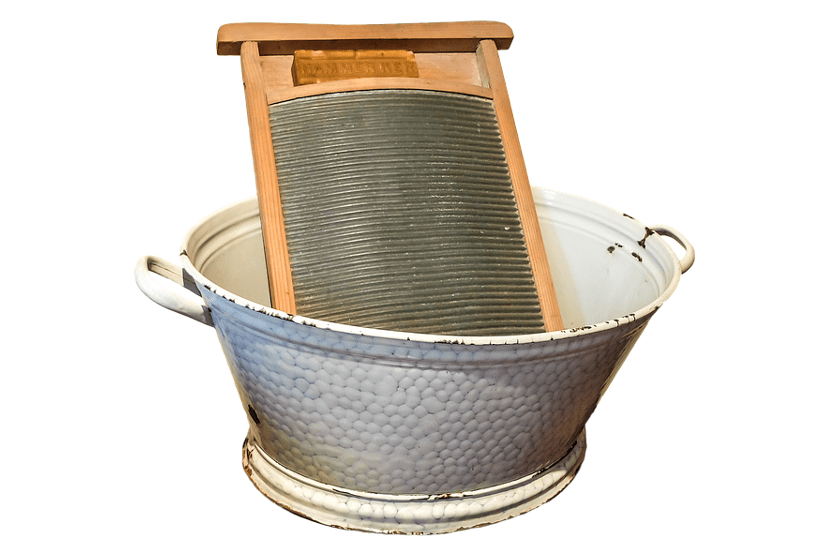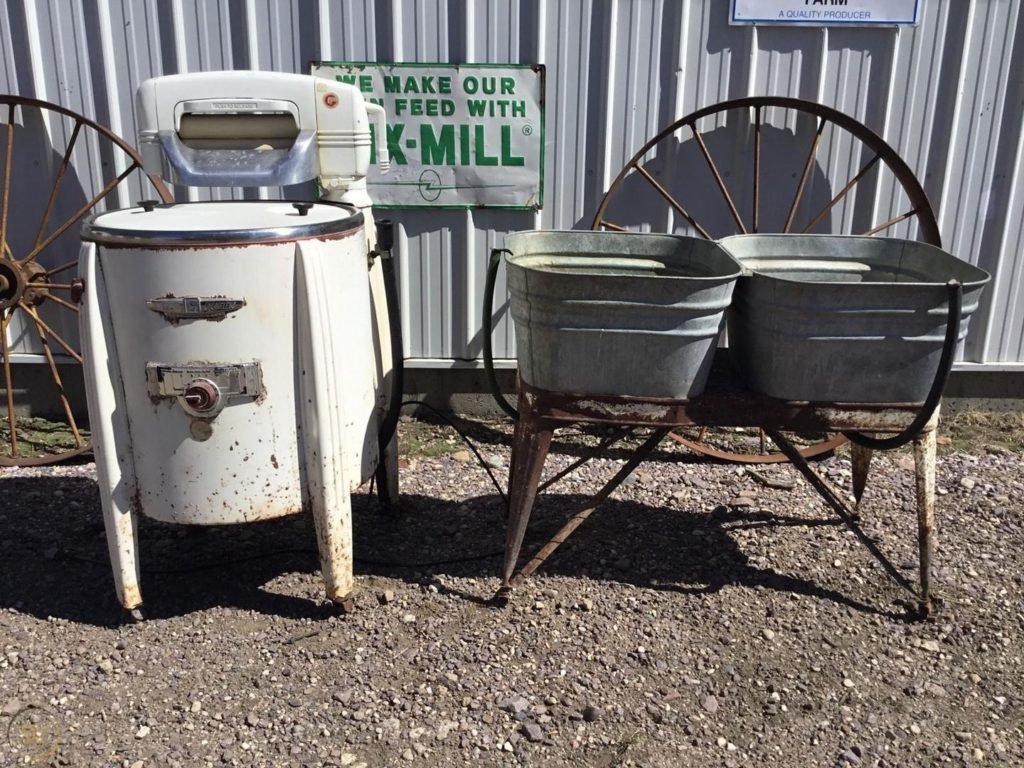Washing machines make life easier, don’t they? All you’ve got to do is toss your dirty clothes in, start the machine, and sometime later, stick them in the dryer or simply hang them out to dry.
That’s how it is now, but what about before washing machines became widely produced? What is the true history of the washing machine? How did it all begin?
The simple scrub board was invented over 200 years ago, and we’ve come a long way since then. From having to do everything by hand we now own fully automated, smart devices that can do so much more than a standard wash.
Of course, before the inception of any time-saving washing devices, people needed to clean their clothes. It wasn’t as efficient or thorough as it could be, but it helped to remove some of the grime and dust after a hard day’s work.
The history of washing goes way back — hundreds of years back, beyond the scrub board, beyond any type of machinery, and all the way into streams of water where clothes were beaten against rocks to shake off the dirt.
What was life like before the invention of washing machines?
Washing before machines

No one can live without water — that’s a fact. Every civilization relied upon a source of water to ensure its survival. In the old days, hundreds or even thousands of years ago, rivers, creeks, and lakes provided more than just refreshment — they were used for washing.
Long before the invention of scrub boards, laundry took place in watercourses. This allowed the water to carry away all the built-up dirt; there was usually quite a lot, as washing was not done anywhere near as frequently as it is now.
To make matters easier, laundry was often slapped against flat rocks, beaten, stepped on, or twisted. Alternatively, washing paddles were used for beating out the dirt. Once the cleaning process was over, the clothes were wrung out until they were close to dry, and then hung out to dry fully.
Laundry in Ancient Rome and Europe
The ways in which clothes are cleaned has evolved with every century and has many differences based on location. As an example, ancient Romans, known for their exceptionally developed urban areas, offered public laundry services. Laundry was done by clothes washers, also known as fullones, in large tubs or vats. The clothing was stamped by the feet of the fullones until achieving a satisfactory level of cleanliness.
In the rest of Europe, laundry was usually done on river banks, and it was a woman’s job. Women washed the clothes of their entire families, and those that were rich enough were able to pay for the service if they didn’t want to do it themselves.
Other than tubs and vats, other interesting devices began cropping up. An example is the possing-tub — a tall tub in which the clothes were stirred and beaten with a plunger. This was extremely physically demanding and was only done on rare occasions.
Approaching the modern washing machine

As the years went on, rather than relying solely on water currents, scrub boards of all kinds started growing in popularity after their invention in the last years of the 1700s. Professional washerwomen also expanded from beyond using only water to clean clothes and turned to soaps.
Soaps that were often used during the washing process were made out of ash lye and animal fat. However, the use of soap did not become widespread until the 18th century, so for hundreds of years, people relied on nothing but their own elbow-grease to keep clean.
Who invented the modern washing machine?
The first English patent under the “washing machines” category was issued in 1691, but the device in question never came to be. Over the next hundred and more years, several devices came and went, but none were enough of an improvement to classify as a washing machine.
As the mid-1800s rolled around, scrub boards, tubs, vats, and all of that were still common practice… but then came the Industrial Revolution. This took place in many areas of the world, but the modern washing machine was actually invented in the United States. There, industrial expansion was rapid and new inventions popped up like fresh flowers in the spring.
The first device that resembled the washing machines of today was patented by an American, James King, in 1851. It used a drum, but it was still hand-powered, so while it was a massive improvement over the scrub board, it didn’t fully revolutionise the washing world.
Then came the rotary washing machine, first shown at the 1862 London Exhibition. It had rollers for wringing and mangling, so everything was still done by hand — just in much less tiresome ways.
In 1858, Hamilton Smith, also an American, received a patent for a device similar to that of James King. Historians often cite Smith and King as the precursors of the modern washers, but their basic concepts were improved upon by others for many years before we reached the first electric washing machine.
The electric washing machine
Not much time had passed between the invention of the early washing machines and electricity becoming commonplace all over the world. As such, the first electric washers were advertised and discussed in newspapers as early as in 1904.
The unfortunate truth behind the washing machine lies in the fact that its true inventor was never named. The patent office has incorrectly credited Alva J. Fisher with the invention of the electric washer. Although there is an earlier patent in the US Patent Office, the true inventor remains unknown.
Despite them being discussed in the papers, electric washers did not become a reality until 1907. This is when the Thor washing machine began being sold commercially by the Chicago-based Hurley Electric Laundry Equipment Company.
The evolution of electric washing machines
The Thor was a drum-type washing machine that had a galvanized tub. Thor’s patent also states: “a perforated cylinder is rotatably mounted within the tub containing the wash water”. Several blades lifted the clothes during the rotation cycle of the cylinder. Once 8 rotations were completed in one direction, the machine then reversed it.
Thor received several upgrades over the years, with innovations such as the tilt-a-whirl agitator. This involved a disk-shaped agitator that tilted back and forth within the washer drum while rotating the whole time. The agitator allowed the water to be moved both horizontally and vertically.
Hurley later combined the washing machine function of Thor with the ability to also wash the dishes. This top-loading machine had both a removable clothes washing drum and a dish-washing drum.
Washing machines after the invention of Thor
In 1911, The Whirlpool Corporation was created — that’s a familiar name, isn’t it? Back then, they were called the Upton Machine Co. and produced electric motor-driven wringer washers.
1937 saw the dawn of the first automatic front loading washing machine. Mechanical timers were incorporated into the design and simplified the process of washing. This machine also had a spinning drum, which did wonders for water extraction and was both easier and safer than manual wringing.
From then on, we drew closer and closer towards the washing machine that we know. In the early days, the motor ran at a constant speed all throughout the wash cycle. While this was possible to manually change, it wasn’t until the 1950s that electrical timers were added to most washers.
These new timers allowed for a lot more flexibility. They were periodically switched off to allow the clothing to soak and were only restarted just before the initiation of the next stage of the process.
Washing machines in the UK

In the UK, electric washers did not become popular until the 1950s. Back in those days, our grandparents owned washing machines that were single-tub, wringer-type machines. This was because fully automatic washing machines had exorbitant prices that most people couldn’t afford.
As the years went on, the washing process became fully automated. Top-loading washers became almost as common as their front-loading counterparts and, over the years, became a must-have appliance present in most homes.
The impact of the washing machine
The history of washing spans across many centuries and each additional invention improved the lives of many by leaps and bounds. However, scientists often speak about the massive impact the widespread distribution of washing machines had on women in particular.
A study conducted by the University of Montreal suggests that:
“The advent of modern appliances such as washing machines and refrigerators had a profound impact on 20th Century society, according to a new study. Plug-in conveniences transformed women’s lives and enabled them to enter the workforce.”
Before the invention of the automatic washing machine, women spent a good chunk of their time doing the washing. This was a very strenuous physical activity that took up a lot of time out of their day. Rich households employed servants that did the washing, which often meant that they were overworked due to the large loads of laundry that these massive households produced.
The washing machine also improved the lives of married women that would otherwise be forced to stay home. As the process became automated, women saved many hours every week and were able to enter the workforce. Of course, this cannot be only attributed to the washing machine, but they definitely played a part.
Aside from the so-called transformation of women’s lives, washers affected us all as a society. The ability to frequently wash our clothing at an increasingly affordable price had contributed to closing the gap between the lower and middle classes. These days, as many homes have a washing machine or access to a laundromat, parents all over the world never have to worry about their children not having a clean outfit for the next day.
The future of washing
Modern washers come with a variety of improvements that differentiate them from the washing machines of old. They’re high-capacity, have stainless steel tubs that are durable and safe to use, and allow you to monitor the load so that you never put in too many clothes at once.
They also have speciality cycles, such as the economy mode that saves water and money, quick wash, anti-allergy, bulk, extra rinse, and so much more. They’re also increasingly eco-friendly, as a lot of emphasis is placed on going green and protecting our planet.
We’ve already gotten so far, so what’s next for the future? Here are some of the things we can expect to happen in the future of washing machines.
- Usage of beads over water – Washing machines, even the most efficient models, still use at least 20 gallons a load. To combat this, Xeros invented a washer that uses polymer beads and reduces water consumption by up to 80 percent.
- Portable washing – As many of us live our lives on the run and travel around more, Dolfi comes to the rescue. It’s a soap-shaped device that will clean your clothes without the use of a washing machine. It can be used on the road and is extremely portable.
- Twin-wash – An interesting invention by LG, twin-wash is a mini-washer that is meant to be slid underneath an existing machine. It washes any extra clothes if you have a huge pile of laundry.
- Steam cleaning – More and more brands are turning towards steam cleaning as a way to efficiently clean clothing without using up too much water. Innova is one of those washing machines that use this technique.
Summary
We’ve come a long way from the days when clothes used to be beaten against rocks or rinsed by the water current on river banks. The evolution of washing, and by extension washing machines, has altered humanity in ways that you would not expect from something that we so often take for granted.
While the changes at first took place gradually and spanned across thousands of years, modern washers seem to be evolving day by day. As we look towards the future, we can only speculate how much the laundry world will change in just the next ten, twenty, or even a hundred years. We’re certain, however, that these changes will be tremendous enough to blow our minds.


